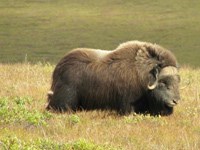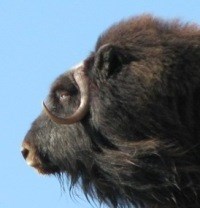
Richard Nelson Pleistocene Survivor If you could step back in time to northern Alaska during the Pleistocene Ice Age, you would see wooly mammoths with long ivory tusks, shambling across the tundra, raising their trunks and trumpeting into the frigid dawn. Perhaps you would see giant steppe bison or saiga antelope or an enormous short-faced bear weighing 1,900 pounds. And perhaps you would see muskoxen … looking pretty much the way they do today. In Gates of the Arctic National Park, this survivor of the Pleistocene—an animal that actually wandered across the vast, grassy steppes of ice-age Alaska—can still be seen. The ancestors of the muskox probably crossed the Bering Land Bridge from Asia to North America 100,000 to 150,000 years ago. During the massive continental glaciations that followed, these animals retreated to a few areas that remained free of ice in northern Canada and Greenland. 
Richard Nelson The “Bearded One” Muskoxen are called Oomingmak in the Inupiaq Eskimo language, meaning “hairy one” or “bearded one,” because of the long, elegant shaggy fur that trails like a skirt along their flanks. The fur is dark brown with a creamy “saddle” across the back, as if it were dusted with snow. Muskoxen are also remarkable for their horns—sweeping down along the side of the face, then curving gracefully upward and outward to slender tips. The bulls’ horns join as a big solid mass across the forehead. Cow horns are much smaller with a fur patch between them on the forehead. |
Last updated: December 16, 2020
